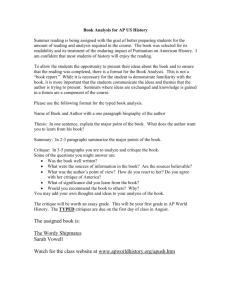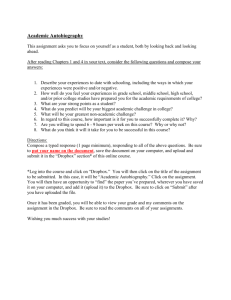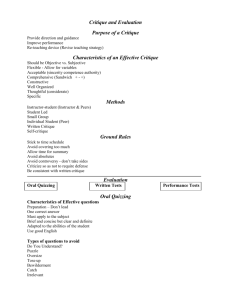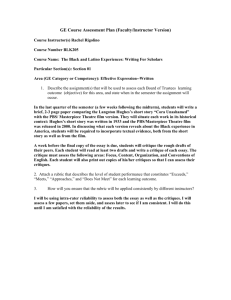Literature Review: Searching and Writing the - dan
advertisement
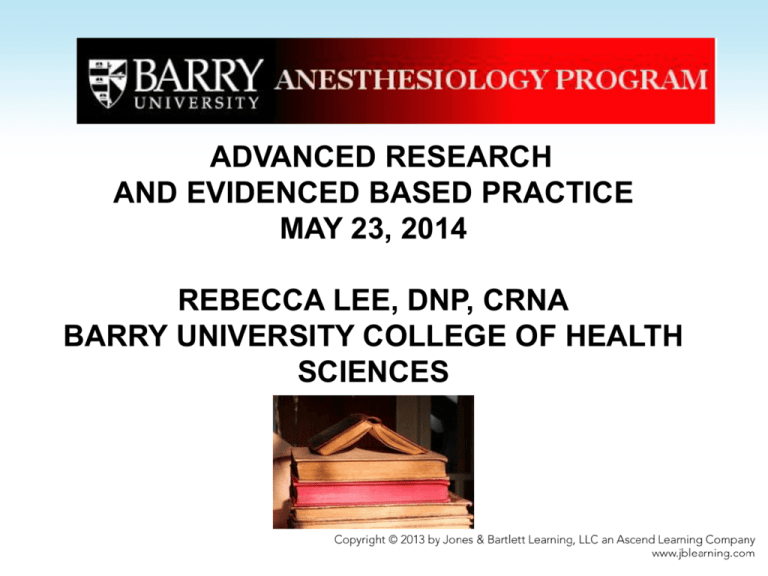
ADVANCED RESEARCH AND EVIDENCED BASED PRACTICE MAY 23, 2014 REBECCA LEE, DNP, CRNA BARRY UNIVERSITY COLLEGE OF HEALTH SCIENCES Chapter Six Literature Review: Searching and Writing the Evidence What is a Literature Review? • Written analytical summary of research finding on a topic of interest • Comprehensive compilation of what is known about a phenomenon • Purpose – assess the evidence • Clear identification of the topic of interest important Purpose of the Review • • • • • • • • • • Identifies a research problem and how it can be studied Helps clarify and determine the importance Identifies what is known Identifies gaps in the knowledge Provides examples Provides evidence of the importance of the problem Identifies theoretical frameworks and conceptual models Identifies experts in the field Identifies research designs and methodologies Provides a context for analysis The Process • Happens early in the process (quantitative) • Can happen at the end (qualitative) • Summarization of the literature usually follows the research problem/question • Sets the stage for the study Conducting a Search • Seek the help of a professional librarian • Research idea – Brainstorm about an idea – Other articles can provide suggestions for the next step • Research question – Helps to be curious about topic – Reading is great source for ideas – Does not have to be etched in stone Database or Search Engine • Search engines – Google/Yahoo/Bing – Take you to the information – Help you retrieve accessible information • Database i.e.MEDLINE – Organized body of related information – Arranged for speed of access and retrieval – Storage location like a library – Two types – bibliographic and fulltext Possible Databases used in Nursing • • • • • • • • MEDLINE CINAHL Cochrane Library Nursing & Health Sciences Nursing Journal PsycINFO AID search EBSCOhost Basics of Searching • Identify concepts from the research question to focus the search • Determine any synonyms for identified concepts (search terms) • Combine search strategies – AND = reduces the number of citations – OR = less restrictive Key Information • Textbooks can be helpful to provide a foundation • Determine the gaps in the literature and authors of major articles • More precise the search = fewer number of resources • More general the search = greater number of resources Evaluating the Literature • Believe that you have analytical skills to base the evaluation upon • Look at the discussion section of article to see the limitations identified for the study • Driving force is to determine if the study supports the question identified and if any gaps are seen Parts to review • • • • • • Purpose of the study Sample size and selection Design of the study Data collection procedures Analysis of the data Conclusion Review areas • Articles – Author’s credentials, citation information • Purpose – Helps to group similar type studies, organizes the material for later summarizing • Sample – Selection process, size of the sample • Method – Implementation of study, inclusion criteria, instruments or surveys used, data collection procedures, data analysis • Major Findings – Gaps noted, limitations, next step in the research process Looking through research articles Creating a table helps with the synthesis of information and organization of data Writing the Literature Review • Not a summary of articles • Synthesis of information about the topic • Purpose – convince the reader about the need to do the study • Format can vary () • Outlines are helpful to manage the amount of data to be organized Writing the Literature Review Understanding what a literature review is… The purpose is to identify what is known and what is not known about a topic. Galvan (2006:72) captures the difference between an annotated bibliography and a literature review very well: "...in essence, like describing trees when you really should be describing a forest. In the case of a literature review, you are really creating a new forest, which you will build by using the trees you found in the literature you read." Double check your writing! Helpful Hints • APA Style • No more than 10 pages • Don’t be quote happy • Synthesize • Use spell check • Review guidelines • Look at the examples under unit resources BB Dropbox for information sharing https://www.dropbox.com/business/business-freetrial?_tk=sem_goog_b&_kw=dropbox|e&_net=g&_ad=350 64061902|1t1&_camp=sem_google_b_dropbox_usenglish&gclid=CKH6gdXonL4CFREV7AodSGwAnQ Dropbox - File sharing and storage made simple Dropbox for Business Dropbox is a free service that lets you bring your photos, docs, and videos anywhere and share them easily. Never email yourself a file again! Read more... Summary Points • • • • Foundation of the research proposal Begins with a good literature search Engage a professional librarian to help Database searches using subject headings yield more precise information • Identify what is known and unknown about the topic • Identify gaps in the literature • Gaps in the literature should support the research question Chapter Thirteen The Research Critique Process and the Evidence-Based Appraisal Process Definition of Critique • Critique is defined as a vital appraisal dealing with examples of art or literature; a decisive dialogue of a precise topic; the ability of analysis • Merriam-Webster Learner's Dictionary (2012): a “a careful judgment in which you give your opinion about the good and bad parts of something (such as a piece of writing or a work of art” (p. 1 Rationale for Doing a Research Critique • Immediate reaction to seek answers to critical questions in nursing practice • Mechanism to provide feedback for improvement • Allows for the advancement of the professional Elements of a Research Critique • • • • • • • • Purpose of a study Design of the research Literature review Research question Sample Data collection process Results Recommendations Process for Doing a Critique • Read the entire study carefully • Examine the organization and presentation • Make a photocopy of the article to allow highlighting • Identify terms you don’t understand and look them up • Identify the strengths and limitations but be objective Critically Assessing Knowledge for Clinical Decision-making • Fundamental importance for implementation of evidence-based practice. • Research critique should be tempered by clinical expertise. • Must be a systematic process to ensure completeness. Decisively Evaluating Quantitative Evidence • Slightly easier to do since quantitative research design tends to be more concrete. • Usual section – introduction, literature review, hypothesis (es), sampling, research design, statistical testing, and discussion • Conceptual framework principle aspect for this type Decisively Evaluating Qualitative Evidence • Slightly different focus • Must discuss researcher-participant relationship • Ethical consideration • Data collection and management • Data analysis which allows for audit of process Decisively Evaluating Mixed Evidence • Embraces both quantitative and qualitative aspects • Rationale for utilization of this method must be provided • Quantitative data discussion usually provided followed by qualitative data but can be in any order • Discussion section must bring both data results together for an integration of the recommendations. The Evidence-based Appraisal • Expert Opinion – When there is no definitive data available – May be expressed in books, conferences, forums, reports or even from expert clinicians in practice – Data internal to an organization – Quality Improvement (QI)/Quality Assurance (QA) • Necessary to provide nurses with knowledge to improve their nursing practice through expert opinion and internal data Summary Points • • • • • • • • Essential to Evidence Based practice Nine different types of critiques Series of questions guide critiques Journal articles have restrictions on length, etc Critique skills developed by repetition Eight general areas of a research study Don’t need to be a statistician to do a critique Quantitative critiques differ from qualitative critiques • Evidence-based appraisals may include evidence from sources other than research

